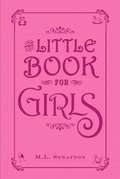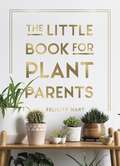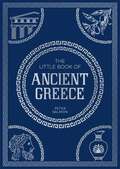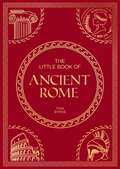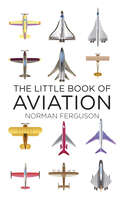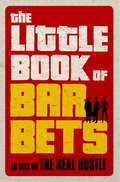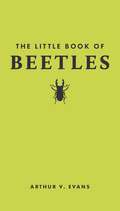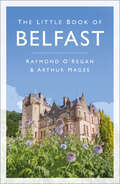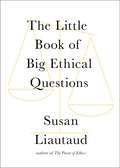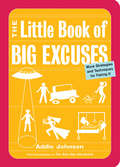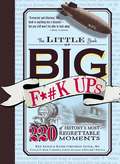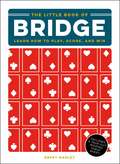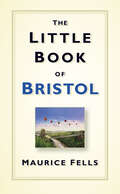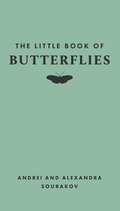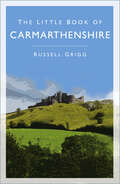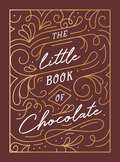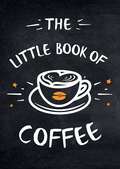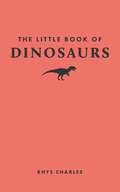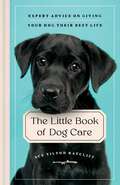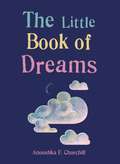- Table View
- List View
The Little Book for Girls
by M. L. StrattonSweet and charmingWild and whimsicalPrecocious and thoughtfulNo matter what type she is, a little girl is something to celebrate!--and this book is the perfect keepsake to remind them just how special they are. With songs, poems, lullabies, rhymes, and games, this timeless treasury celebrates all things girl. From Little Miss Muffet to making sugar cookies--these time-honored traditions will create unforgettable memories for every kind of little girl for years to come.
The Little Book for Plant Parents: Simple Tips to Help You Grow Your Own Urban Jungle
by Felicity HartAll you need is love. And a plant.Whether you’re a plant lover looking for seeds of inspiration, or a beginner hoping to cultivate your very own urban jungle, this little book is bursting with tips and ideas to help you hone your green fingers and become a true plant parent.
The Little Book for Plant Parents: Simple Tips to Help You Grow Your Own Urban Jungle
by Felicity HartAll you need is love. And a plant.Whether you’re a plant lover looking for seeds of inspiration, or a beginner hoping to cultivate your very own urban jungle, this little book is bursting with tips and ideas to help you hone your green fingers and become a true plant parent.
The Little Book of Ancient Greece: A Pocket Guide to an Epic Civilization, Including Key Events, People, Trivia and More
by Summersdale PublishersIf you've ever been curious about the rich culture and vibrant history of Ancient Greece, dive into this whirlwind tour of the highlights of this epic civilization. From warfare and politics, to art, culture and everyday life, uncover the key events, people and trivia you need to know to understand this remarkable period of history.
The Little Book of Ancient Rome: A Pocket Guide to an Epic Civilization, Including Key Events, People, Trivia and More
by Summersdale PublishersGrowing from humble origins into a world-spanning empire, the Ancient Roman civilization has captured human imagination for generations. Uncover its history, from the legendary Roman army and its conquests to the art, culture and everyday life of its citizens, in this fascinating little book, which will be your pocket-sized window into the past.
The Little Book of Aviation (Little Book Of)
by Norman FergusonThe Little Book of Aviation is a collection of facts, figures and interesting stories from the world of flight. Sad, humorous, baffling and astounding stories abound, from the pioneering days of the Wright Brothers to the present day, and covering everything from great milestones, famous names who’ve served, and the greatest of aircraft icons; phantom pilots and aircraft and a glossary of slang; the origins of plane-spotting and unusual aircraft names; great feats and enduring mysteries; lucky escapes and great aircraft in the movies… the trivia is limitless and will appeal to everyone, whether you want help telling your Spitfire from your Messerschmitt or you know a Spitfire I from a Spitfire II!
The Little Book of Bar Bets
by Guy AdamsCan you lift a glass filled with drink off a table using just a playing card? Or balance 13 dominoes on a single domino? Or drink a beer quicker than your friends every time? THE LITTLE BOOK OF BAR BETS is a fun and humorous gift book that will appeal not only to fans of hit BBC series The Real Hustle, but to anyone anywhere in the world who likes pub games. Bets include: PURSE SNATCH: Using no hands, get a coin from between your teeth into a purse on your head. Impossible? MAGIC MATCH: Can you move the match behind the glass without touching it? THE INDESTRUCTIBLE BALLOON: Who can hold a balloon over a flame the longest before it bursts?
The Little Book of Beetles (Little Books of Nature #2)
by Arthur V. EvansA charming, richly illustrated, pocket-size exploration of the world&’s beetlesPacked with surprising facts, this delightful and gorgeously designed book will beguile any nature lover. Expertly written and beautifully illustrated throughout with color photographs and original color artwork, The Little Book of Beetles is an accessible and enjoyable mini reference about the world&’s beetles, with examples drawn from across the globe. It fits an astonishing amount of information in a small package, covering a wide range of topics—from anatomy, diversity, and reproduction to habitat and conservation. It also includes curious facts and a section on beetles in myths, folklore, and modern culture from around the world. The result is an irresistible guide to the amazing lives of beetles.A beautifully designed pocket-size book with a foil-stamped cloth coverFeatures some 140 color illustrations and photosMakes a perfect gift
The Little Book of Belfast (Little Book Of)
by Raymond O'Regan Arthur MageeThe Little Book of Belfast is a compendium of fascinating, obscure, strange and entertaining facts about the city of Belfast past and present. Funny, fast-paced and fact-packed, here you will find out about Belfast’s trade and industry, crime and punishment, music, literature and sport, architectural heritage, and its famous (and occasionally infamous) men and women. It covers not only the famous elements in Belfast’s history but also unusual, little-known facts that could so easily have been forgotten. A reliable reference book and a quirky guide, this can be dipped into time and time again to reveal something new about the people, the heritage and the secrets of this ancient city.
The Little Book of Big Ethical Questions
by Susan LiautaudPerfect for your next dinner party discussion, The Little Book of Big Ethical Questions presents some of today&’s most thought-provoking ethical questions in a welcoming, easy-to-discuss Q&A format, with guidance from a renowned ethicist.Often a single question can spark a meaningful exchange—like &“Would you apply for a job you know your friend is applying for?&” Or &“Should voting be mandatory?&” Or what about police using facial recognition technology? Questions like these spur us to consider: What would I have done? Is there one correct answer? And ultimately: How can ethics help us navigate these situations to find the best outcome for ourselves and others? An ethicist who advises leaders and organizations worldwide, Susan Liautaud asks intriguing questions that encourage lively discussion across a range of subjects, from family and friends to health and technology to politics, work, and consumer choices. She then walks through the ways you might approach each situation to find the best answer for you. Grab the book, gather a few friends, and dive in!
The Little Book of Big Excuses: More Strategies and Techniques for Faking It (Humour Ser.)
by Addie JohnsonThis indispensable reference guide offers hundreds of excuses for thousands of situations—from missed birthdays to unpaid parking tickets and more!Nobody ever said being an adult was easy. But it's definitely easier with hundreds of excuses for things you did, didn't do, or simply never want to hear about again. The Little Book of Big Excuses is your guide to saving face, avoiding blame, and getting out of almost any unpleasant situation. In &“Fake, Don't Flake" you&’ll learn how to successfully show up late—or not at all—to any number of places for any number of reasons. "Excusez-Moi, si'l vous plait" tells you just the right words to say if you're caught wearing a halter top to a black tie event. Or forget your boss's spouse's name (again). Or don't want to pick up the tab. The French have a word for everything. And you&’ll always have an excuse for not calling, IMing, or emailing with the bonus chapter: &“Delivery Subsystem Failure—Mailboxes, Messages, Missives Gone Awry, Oh My!&”.
The Little Book of Big F*#k Ups: 220 of History's Most-Regrettable Moments
by Ken Lytle Katie Corcoran LytleNobody's perfect. Every day, some guy forgets his wife's birthday, some schmuck drives his Corolla into the Lexus in front of him, and some mother forgets to make cupcakes for her kid's school bake sale. But you'll never sweat the small stuff again. This book gives these denizens of disaster a major self-esteem boost by detailing 220 of the world's most easily avoided catastrophes, such as:The Donner party camping trip. Oh, pioneers! The Sierra Nevadas are not a winter wonderland. Guess you learned the hard way. The sinking of the RMS Titanic. Hello!? Does anyone see that huge iceberg? No? Okay then. Madame Curie's death from radium poisoning. Come on, Marie, put on a Hazmat suit, will ya? Your creepy glow-in-the-dark skin is freaking everyone out. After all, everyone makes mistakes. It's just that some people's faux pas are worse--way, way worse--than others.
The Little Book of Big F*#k Ups: 220 of History's Most-Regrettable Moments
by Ken Lytle Katie Corcoran LytleNobody's perfect. Every day, some guy forgets his wife's birthday, some schmuck drives his Corolla into the Lexus in front of him, and some mother forgets to make cupcakes for her kid's school bake sale. But you'll never sweat the small stuff again. This book gives these denizens of disaster a major self-esteem boost by detailing 220 of the world's most easily avoided catastrophes, such as:The Donner party camping trip. Oh, pioneers! The Sierra Nevadas are not a winter wonderland. Guess you learned the hard way.The sinking of the RMS Titanic. Hello!? Does anyone see that huge iceberg? No? Okay then.Madame Curie's death from radium poisoning. Come on, Marie, put on a Hazmat suit, will ya? Your creepy glow-in-the-dark skin is freaking everyone out.After all, everyone makes mistakes. It's just that some people's faux pas are worse--way, way worse--than others.
The Little Book of Big Questions: 200 Ways to Explore Your Spiritual Nature
by Jonathan RobinsonA collection of perennial questions about the nature of God, the reason for evil, the meaning of death, the variety of spiritual experiences, and similar subjects offers a simple, effective tool for exploring all aspects of spirituality.
The Little Book of Bridge: Learn How to Play, Score, and Win (The Little Book of)
by Brent ManleyA comprehensive guide to the classic card game of bridge, including an overview of the basics, tips and techniques how to play—and strategies to win; perfect for new bridge players and experienced pros alike.Bridge is all about memory, bidding, and skill. It is one of the most popular card games in the world, and is played by millions of people worldwide in tournaments, clubs, and cruises, as well as online. New to the world of bridge? No problem! Learning any new game can be challenging, especially one as complicated as bridge. But mastering a complex game can be very rewarding. Whether you are a complete novice or a casual player looking to brush up on your skills and techniques, The Little Book of Bridge can help you play your cards right and get ahead in this classic game. With a comprehensive breakdown of all the cards involved in the game, detailed information on scoring, tips on how to improve your skills, strategies for winning, and a tear-away cheat sheet, this guide will have even the newest bridge enthusiast winning in no time flat.
The Little Book of Bristol (Little Book Of)
by Maurice FellsThe Little Book of Bristol is an intriguing, fast-paced, fact-packed compendium of places, people and trivia. A rich, and indeed sometimes bizarre, thread of history weaves its way through the ‘Bristol story’. Find out all manner of things from why local women were allowed to hang out their washing at a local beauty spot to why local bye-laws restrict carpet beating to certain hours. Along with a fresh look at city life past and present, these and many more anecdotes will surprise even those Bristolians who thought they really knew their city.
The Little Book of Butterflies (Little Books of Nature #1)
by Andrei Sourakov Alexandra A. SourakovA charming, richly illustrated, pocket-size exploration of the world&’s butterfliesPacked with surprising facts, this delightful and gorgeously designed book will beguile any nature lover. Expertly written and beautifully illustrated throughout with color photographs and original color artwork, The Little Book of Butterflies is an accessible and enjoyable mini reference about the world&’s butterflies, with examples drawn from across the globe. It fits an astonishing amount of information in a small package, covering a wide range of topics—from anatomy, diversity, and reproduction to habitat and conservation. It also includes curious facts and a section on butterflies in myths, folklore, and modern culture from around the world. The result is an irresistible guide to the amazing lives of butterflies.A beautifully designed pocket-size book with a foil-stamped cloth coverFeatures some 140 color illustrations and photosMakes a perfect gift
The Little Book of Carmarthenshire (Little Book Of)
by Russell GriggDid You Know?Carmarthen is believed to be the oldest town in Wales. The first canned beer in the United Kingdom was produced in Llanelli. The National Botanic Garden of Wales has the largest single-span glasshouse in the world. Fast-paced and fact-packed, this compendium revels in Carmarthenshire's rich heritage and what makes it special in areas such as culture, landscape, wildlife, food and sport.This whistle-stop tour through the ‘Garden of Wales’ covers both celebrated characters and murky pasts, taking in the county’s breathtaking castles, nature reserves and famous landmarks along the way. From the county gaol and asylum to school strikes and industrial riots, this is a book you won’t want to put down.
The Little Book of Chocolate: A Rich Collection of Quotes, Facts and Recipes for Chocolate Lovers
by Summersdale PublishersWhether you like your chocolate to be milk or dark, in a bar or in a cake, there is one thing that's certain: we are all hooked on this tantalizing treat. Indulge all your chocolate cravings in this tempting collection of recipes, fascinating facts and memorable musings on the most sumptuous of sweets.
The Little Book of Coffee: A Collection of Quotes, Statements and Recipes for Coffee Lovers
by Summersdale PublishersThere are more ways to enjoy your java than there are coffee beans on the tree, so whether you like your coffee topped with foam or black as the night sky there’s something for everyone! Bringing together the finest blend of recipes, clever statements and quips from connoisseurs the world over, this book celebrates the majestic coffee bean.
The Little Book of Coffee: A Collection of Quotes, Statements and Recipes for Coffee Lovers
by Summersdale PublishersThere are more ways to enjoy your java than there are coffee beans on the tree, so whether you like your coffee topped with foam or black as the night sky there’s something for everyone! Bringing together the finest blend of recipes, clever statements and quips from connoisseurs the world over, this book celebrates the majestic coffee bean.
The Little Book of Dinosaurs (Little Books of Nature)
by Rhys CharlesA charming, richly illustrated, pocket-size exploration of dinosaursPacked with surprising facts, this delightful and gorgeously designed book will beguile any dinosaur lover. Expertly written and beautifully illustrated throughout with color photographs and original color artwork, The Little Book of Dinosaurs is an accessible and enjoyable mini-reference. It fits an astonishing amount of information in a small package, covering a wide range of topics—from dinosaur diversity and social behaviors to their extinction and rediscovery. It also includes curious facts and a section on dinosaurs in myths, folklore, and popular culture from around the globe. The result is an irresistible guide to the amazing world of dinosaurs.A beautifully designed pocket-size book with a foil-stamped cloth coverFeatures some 140 color illustrations and photosMakes a perfect gift
The Little Book of Dog Care: Expert Advice on Giving Your Dog Their Best Life
by Ace Tilton RatcliffAn essential guide to caring for your dog, filled with expert-backed tips and nuggets of advice to help every dog-owner understand what their canine companion needs in order to be happy and healthy.In the Little Book of Dog Care, life-long dog lover and deathcare veterinary practice owner Ace Tilton Ratcliff delivers a must-have primer for every dog parent. What should you do when your dog is scared during a thunderstorm? How can you make clipping their nails less miserable? When do they like to eat? What can&’t you feed them? Endless questions, expert-certified answers. Thoughtfully divided into chapters that focus on a specific aspect of care, from sleeping to grooming and beyond, these tips and tricks are applicable to any breed of dog. By the last page, every dog owner will better understand what their dog might be feeling—and how to best assist, using your enviable opposable thumbs.
The Little Book of Dreams
by Una L. TudorEveryone from the pharaohs to Freud has had something to say about dreams. Used for both prophecy and psychoanalysis, they serve as a doorway to the soul and a window to the subconscious.We are, after all, such stuff as dreams are made on - and as such an understanding of our dreams helps us to understand ourselves, and our lives, and our deepest desires and fears better.This little book sifts through many centuries of wisdom to create a practical, reassuring and above all useful guide to the third of our lives we spend asleep.The Little Book of Dreams is a beautifully colour-illustrated guide to your dreams. Filled both with practical information on improving your night's sleep and advice on maintaining a 'moon journal' as well as what crystals to bring into the bedroom with you. This handy little book will help you to unlock what your unconscious mind is trying to tell you.
The Little Book of Dreams
by Una L. TudorEveryone from the pharaohs to Freud has had something to say about dreams. Used for both prophecy and psychoanalysis, they serve as a doorway to the soul and a window to the subconscious.We are, after all, such stuff as dreams are made on - and as such an understanding of our dreams helps us to understand ourselves, and our lives, and our deepest desires and fears better.This little book sifts through many centuries of wisdom to create a practical, reassuring and above all useful guide to the third of our lives we spend asleep.The Little Book of Dreams is a beautifully colour-illustrated guide to your dreams. Filled both with practical information on improving your night's sleep and advice on maintaining a 'moon journal' as well as what crystals to bring into the bedroom with you. This handy little book will help you to unlock what your unconscious mind is trying to tell you.
